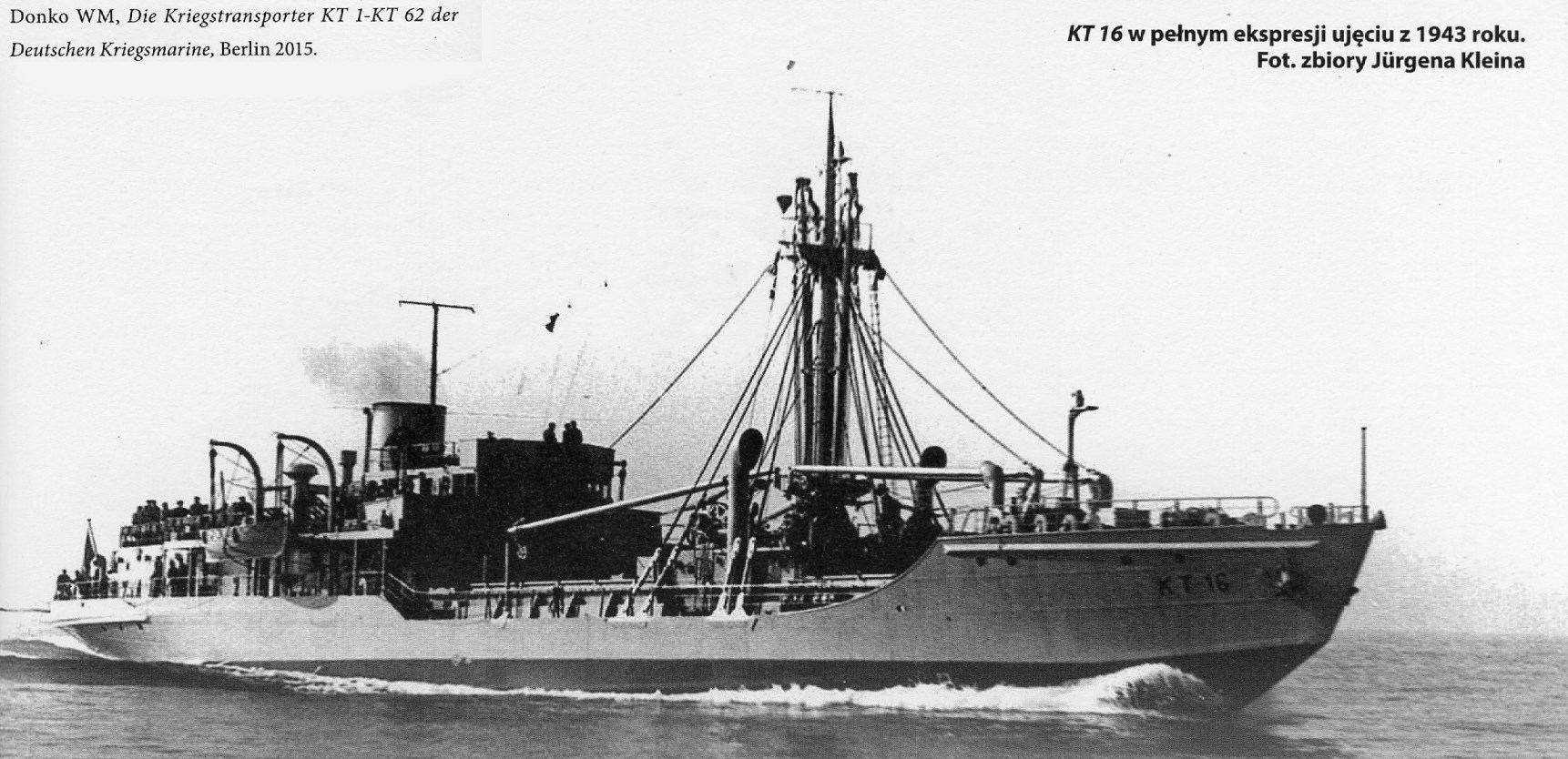
They were developed and built to strengthen the short German
transport capacity in the Mediterranean and the Black sea, some of which they
converted into submarine chasers. Kriegstransporters or KT boats: small, armed
transport vessels displacing ~850 tons each (about the size of British
corvettes) that could make the run from Sicily to Tunisia at a modest fourteen
knots, usually by night.
The bow of these ships was clearly an ice breaking one good
for the Baltic or even northern seas. They have all a kind of icebreaking bow
with the exception of KT6 and perhaps KT3, which have a much rounder form.
The developing building yard was Deutsche Werft Hamburg
(only KT3), all the others were built in Italy (Genoa, Ancona, Riva Trigoso,
Livorno), Austria (Linz, Korneuburg), Hungary (Obuda) and Soviet Union
(Nikolajev).
A small type of prefabricated steamship of easy construction
called the Kriegstransporter was planned. Deutsche Werft in Hamburg was given
responsibility for drawing up the detailed plans for the ship and constructing
the prototype. This was KT 3, launched on 1 August 1942 and completed six weeks
later on 16 September. It was planned that the remainder of the ships would be
built in Italy. Prefabricated parts were to be made in Germany for the first
batch of twenty ships and sent south by train, to be assembled initially in
Genoa by Ansaldo Sestri. The first two Italian-built ships were KT 1 launched
on 5 September 1942 and completed on 14 November, and KT 2 launched on 12
September and completed on 9 December. No other vessels were completed that
year. The principal dimensions as reported by Wilhelm Donko in his book Die
Kriegstransporter KT 1 – KT 62 der Deutschen Kriegsmarine were:
Specification
795/834 BRT, 700 t, 62,00/67,50, later 63,00/67,50 x 11,00 x
1,80/3,10 m, 2400 PSi, 14,5 kn, 160 t of coal, range 1250 nm, 2 triple
expansion machines, 3, later only 2 boilers, crew 53, 2×7,5cm, 1×3,7cm, 2x2cm,
2MG
Length: 62 metres
Width: 11 metres
Height to main deck: 4.2 metres
Draught: 2.9 metres
Displacement loaded: 1,200 tons
Stowage space: 980 cubic metres
Hatch 1: 6.75 by 5.4 metres
Hatch 2: 9.8 by 7.4 metres.
The larger Kriegstransporter had a deadweight capacity of
400 tons and could carry six tanks in the single hold, two via the forward
hatch and four via the after hatch. They had two coal-fired water-tube boilers,
supplying steam to twin triple-expansion steam engines which provided a maximum
speed of 14½ knots. The bunker capacity was 400 tons of coal, which gave them a
range of up to 1,500 miles. The Kriegstransporter could unload tanks and other
heavy equipment using its own 30-ton derrick mounted on the mainmast situated
between the two hatches. The KT ships also had four 5-ton or three 5-ton and
one 10-ton derrick, similarly mounted. They had a crew complement of
fifty-three.
The ships had a blunt raked bow to halfway down to the
waterline with the forefoot cut away below this at a steeper rake. This was a
simple design feature that avoided the use of shaped frames and plates. The
ships had a short, triangular-shaped forecastle and the machinery spaces were
aft, over which was the accommodation for officers and crew. The transom stern
was slightly raked.
The building programme was presented to the commander of
German naval transport in Italy at Genoa on 24 January 1942. An officer from
the German naval high command supported by the director of Deutsche Werft made the
presentation, when it was hoped that the first keel could be laid in March. At
a meeting three days later with representatives from the four shipyards
designated to carry out the building programme, along with the Italian naval
ministry, it was concluded that twelve ships should be built by the end of the
year, with the remaining eight of the first batch to follow in 1943. This
meeting was followed by another during the morning of 28 January in the naval
ministry, at which the Germans learned that intervention by the Italian
Minister for Transport required the programme to be halved. This reduction was
necessary in order not to jeopardise the existing Italian shipbuilding
programme. The new German programme now foresaw five completions only in 1942,
with the remainder coming in the fourth quarter of 1942. In the event, only two
were completed in 1942: KT 1 and KT 2.
By the end of the war, forty KT ships had been completed in
Italian yards (at Genoa, Ancona, Iva, Trigoso and Livorno), thirty of them by
Ansaldo at Genoa. Two were built at Toulon and others were built in Austria
(Linz, Korneuburg), Hungary (Obuda) and Russia (Nikolajev). Although sixty-two
were planned, contracts for the last two ships were never issued.
Only one of the KT ships ever flew the Red Ensign post-war.
This was Empire Stevedore, which was the original prototype Kriegstransporter
KT 3. She was captured towards the end of the war and was taken over at Hamburg
in October 1949 by the Royal Engineers, who moved her to Marchwood, minus her
engine, for use as a military stevedore training ship, replacing Empire
Flamian. Empire Stevedore, it seems, was haunted. Her last German captain shot
himself when the ship was captured and his ghost, looking through binoculars
towards the bow of the ship, regularly appeared in the wheelhouse shortly after
midnight. Those aboard ship after midnight often reported hearing the captain’s
footfalls as he climbed the ladder to the bridge.